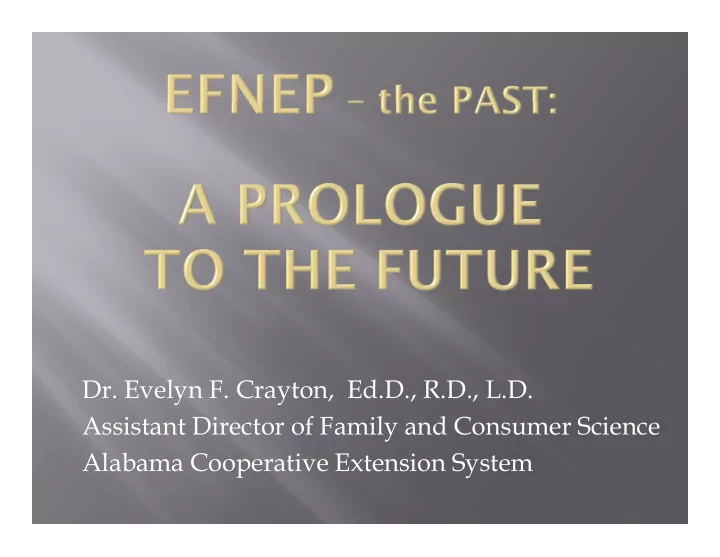

D E Dr. Evelyn F. Crayton, Ed.D., R.D., L.D. l F C t Ed D R D L D Assistant Director of Family and Consumer Science Alabama Cooperative Extension System l b C S
EFNEP EFNEP WHO? WHO? WHAT? WHAT? WHEN? WHERE? WHEN? WHERE?
U. S. Secretary of Agriculture U. S. Secretary of Agriculture 1961-1969 Orville Freeman Orville Freeman Governor of Minnesota 1955-1961 � Graduate of University of Minnesota � Initiated Food Stamp Program �
Extension Service Administrator Lloyd H. Davis Lloyd H. Davis 1963-1970 Cornell University graduate � Assistant county agent and specialist in New York Assistant county agent and specialist in New York � � Associate Director in Massachusetts � Deputy Administrator on federal level before � b becoming the administrator. i th d i i t t
� Division of Home Economics Federal Extension Service, USDA � Dr. Margaret C. Browne g � National Extension Staff � Nancy Leidenfrost-EFNEP Leader Nancy Leidenfrost EFNEP Leader � Evelyn Spindler, Specialist � Evelyn Johnson, Specialist y p � Margaret Oliver-Program Leader Margaret Oliver Southern Region, FES Consultant � Dr. Fred Frutchey, FES Specialist, Consultant
Nutrition Education for Low-Income (Limited Resource) People � Fundamental objective of EFNEP : � Promote sound nutritional principles among low � Promote sound nutritional principles among low- income families. � Focuses on nutrition and nutrition-related d l d knowledge and skills. � Teaches poor families the knowledge of how to use the already available food resources and the importance of the nutritional value of those foods. t e ut t o a va ue o t ose oods.
Clearly Defined Guidelines: Clearly Defined Guidelines: � Paraprofessional aides when carefully � Paraprofessional aides, when carefully trained and appropriately supervised, could work effectively to improve the diets y p of low-income families. � Existing Extension home economics programs could be modified to more effectively reach low-income families.
� 1964 – Nutrition Education Program for Low-Income Families – Taught by program aides indigenous to the g y p g g population (piloted in five states). � 1969 –In 1968 $10 million was appropriated by � 1969 –In 1968, $10 million was appropriated by Congress. Thus, EFNEP was initiated in the U. S. Department of Agriculture. Funds were allocated to the states based on the number of low income families in each state. � 1970 – Youth Phase targeted children from 9-19 to � 1970 Youth Phase targeted children from 9 19 to teach them the same principles as the adult phase. � 2006 � 2006 – Historically Black Colleges and Universities Historically Black Colleges and Universities (1890) received EFNEP funding.
PILOT STATES PILOT STATES � Rhode Island: Traditionally rural home economics programs were modified for economics programs were modified for use in urban slums. � Texas: Home visits and circular letters were two most popular methods to reach Mexican-American families .
� Massachusetts : Nutrition programs were p g tailored to meet the needs of families in large, urban housing developments. g g p � Missouri : Again paraprofessionals were � Missouri : Again, paraprofessionals were enlisted to help low-income families , particularly those living in urban slum particularly those living in urban slum neighborhoods, incorporate nutritional principles into their daily lives principles into their daily lives.
ALABAMA The most ambitious and best documented study was a five year pilot. Paraprofessional Paraprofessional aides contacted families on a one-to- one basis and taught b d h homemakers food and nutrition and other homemaking skills.
Fred Robertson, Director , Cooperative Extension Service 4/1/61 – 2/28/71 Harvard Graduate � Professor of Ag Economics at AU � Assistant Director of Extension in 1960 Assistant Director of Extension in 1960 � � Acting Director in 1961 � Director in 1962 �
Orville Freeman, Secretary of Agriculture, visited – g Mary Jim Coleman, Project Leader Jeanne Priester, Educational Specialist Mary Jim Coleman, Dottie Tate, State Leader J Jeanne Priester, P i t Virginia Marable Beck Ms. Farriss Prickett, Foods and Nutrition Specialist Education Specialist
Baldwin –Calhoun – Houston – Marion – Walker Barbara Mobley, Calhoun County Then-1964 Retired EFNEP Coordinator L-R: Dr. Evelyn F. Crayton, Now-2004 Mary Jim Coleman B tt M Betty Moore � Jeanne Priester Mrs. Eugel Belk Virginia Marable Goebel Beck Marion County Program Aide
Recommend
More recommend